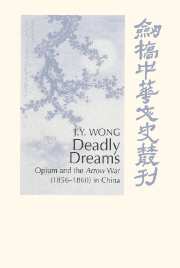Book contents
- Frontmatter
- Contents
- List of Tables
- List of Figures
- Poem by the late Mr Qin Esheng
- Foreword by Professor Wang Gungwu
- Foreword by Professor C. A. Bayly
- Preface
- Part I The confusion of imperialism
- Part II The pretext for imperialism
- Part III The personalities of imperialism
- 3 Harry Parkes: ‘If you would read a little international law.’ – Punch.
- 4 Sir John Bowring: Possessed by a monomania
- 5 Commissioner Yeh: A ‘monster’?
- 6 Rule Britannia and vox populi, vox Dei
- Part IV The rhetoric of imperialism
- Part V The mechanics of imperialism
- Part VI The economics of imperialism
- Part VII The dynamics of imperialism
- Chronology of major events
- Word list
- Abbreviations
- Bibliography
- Index
5 - Commissioner Yeh: A ‘monster’?
Published online by Cambridge University Press: 29 September 2009
- Frontmatter
- Contents
- List of Tables
- List of Figures
- Poem by the late Mr Qin Esheng
- Foreword by Professor Wang Gungwu
- Foreword by Professor C. A. Bayly
- Preface
- Part I The confusion of imperialism
- Part II The pretext for imperialism
- Part III The personalities of imperialism
- 3 Harry Parkes: ‘If you would read a little international law.’ – Punch.
- 4 Sir John Bowring: Possessed by a monomania
- 5 Commissioner Yeh: A ‘monster’?
- 6 Rule Britannia and vox populi, vox Dei
- Part IV The rhetoric of imperialism
- Part V The mechanics of imperialism
- Part VI The economics of imperialism
- Part VII The dynamics of imperialism
- Chronology of major events
- Word list
- Abbreviations
- Bibliography
- Index
Summary
I. Introduction
We have seen how determined Sir John Bowring was to be received by Commissioner Yeh inside Canton, and how equally determined Yeh was to deny him that pleasure. In this chapter, we shall explore the reasons.
During the hostilities, Chinese soldiers did not discriminate between British civilians and British servicemen. They also ambushed individual British soldiers. On 5 December 1856, a marine and a seaman strayed from the Macao Fort, contrary to orders, to purchase vegetables. The marine was killed. The seaman jumped into the river and drowned. The largest-scale attack on civilians happened on 30 December. The postal steamer Thistle, on her way from Canton to Hong Kong, was taken over by Chinese soldiers disguised as passengers. Eleven Europeans, including the Spanish vice-consul at Whampoa, were killed.
In the age of imperialism, empire builders thought there was nothing wrong with shelling densely populated Canton at ten-minute intervals for days on end, or even deliberately setting fire to hundreds of packed civilian houses, causing numerous deaths. But the moment some Caucasian civilians were killed and a couple of British soldiers ambushed, there was a trerrific outcry. The death of the marine was depicted by Harry Parkes as a barbarous assassination and by Admiral Seymour as murder. The attack on the Thistle was described by the admiral as ‘a most horrible massacre’ and by Bowring as a ‘treacherous surprise’. Condemnations by members of the British Parliament will be examined later. In sum, many Britons regarded Yeh as a monster.
- Type
- Chapter
- Information
- Deadly DreamsOpium and the Arrow War (1856–1860) in China, pp. 109 - 127Publisher: Cambridge University PressPrint publication year: 1998



